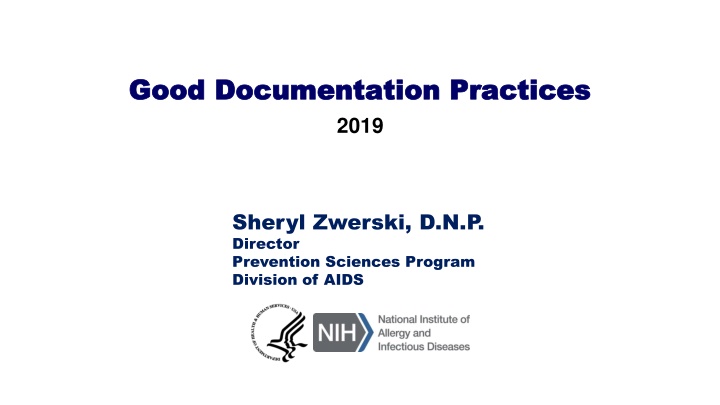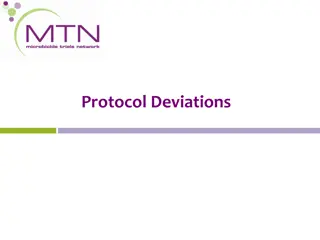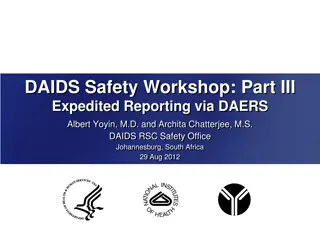
Best Practices for Clinical Trial Documentation and Compliance
Ensure compliance with regulatory standards by documenting all aspects of a clinical trial effectively. Learn the importance of complete and accurate records, examples of inadequate documentation, and the impact of gaps in documentation on regulatory decision-making.
Uploaded on | 1 Views
Download Presentation

Please find below an Image/Link to download the presentation.
The content on the website is provided AS IS for your information and personal use only. It may not be sold, licensed, or shared on other websites without obtaining consent from the author. If you encounter any issues during the download, it is possible that the publisher has removed the file from their server.
You are allowed to download the files provided on this website for personal or commercial use, subject to the condition that they are used lawfully. All files are the property of their respective owners.
The content on the website is provided AS IS for your information and personal use only. It may not be sold, licensed, or shared on other websites without obtaining consent from the author.
E N D
Presentation Transcript
Good Documentation Practices Good Documentation Practices 2019 Sheryl Zwerski, D.N.P. Director Prevention Sciences Program Division of AIDS
Goal for Todays Meeting Goal for Today s Meeting 1. Summarize lessons learned from recent regulatory inspections surrounding documentation 2. Provide examples of inadequate documentation 3. Provide high level summary of goals and impact 4. Conduct an open question and answer session to address network-specific concerns 2
Why Document? Why Document? ICH E6 R2, Good Clinical Practice, Section 8 Essential Documents To individually and collectively enable evaluation of the conduct of a trial and the quality of the data produced. The documentation has to tell the story of the study to someone who was not involved and has little to no knowledge of the history. If it isn t documented, it didn t happen. 3
Goal and Impact of Gaps in Documentation Goal and Impact of Gaps in Documentation Are you confident we could clearly reconstruct every step in the life cycle of a trial? If not, then regulatory agencies are put in a very difficult position - being responsible for deciding whether to approve products that could impact millions of people without adequate evidence to base their decision on. 4
Principles of GDP Principles of GDP GDP is the method for recording, correcting, and managing data, documents, and records to ensure the reliability and integrity of information and data throughout all aspects of a clinical trial. A ttributable L egible C ontemporaneous O riginal A ccurate C omplete 5
Examples of Inadequate Documentation Examples of Inadequate Documentation Curricula Vitae are not signed and are provided in MS-Word format Training documentation incomplete 6
Maintaining Complete and Accurate Records of Staff Maintaining Complete and Accurate Records of Staff Qualifications and Training Throughout the Study Qualifications and Training Throughout the Study Documentation of trainings must be complete for all staff from study start and updated as required during the course of the study. Group trainings should be documented on a sign-off sheet that includes: Session Purpose/Title Session Date Session Presenter Signature of Attendees CVs should be signed and dated, and the originals saved in a non-editable format. CVs and training documentation should be kept in an organized fashion in secure file storage. 7
Examples of Inadequate Documentation Examples of Inadequate Documentation Protocol documents exist in multiple versions and dates to denote both the Sponsor-approved version and the IRB/EC approved version Implementation of changes to study without amendment or Letter of Amendment (LOA) documented and/or reviewed by appropriate personnel Study Specific Procedures or Manual of Operations with incorrect versions and dates 8
Ensuring Documentation and Sponsor Approval Prior to Ensuring Documentation and Sponsor Approval Prior to Implementation of any Study Conduct Changes Implementation of any Study Conduct Changes The DAIDS Guidance for Determining the Appropriate Use of Full Version Protocol Amendments, Letters of Amendment, and Clarification Memos during the Lifecycle of a DAIDS-Approved Protocols was developed to assist Protocol Teams, DAIDS Staff, and other Stakeholders in choosing the appropriate method for clarifying or making changes to DAIDS approved protocols. The Sponsor (i.e., DAIDS) should be involved in, and provide approval for, any and all decisions to deviate from, or make changes to the protocol, except where necessary to eliminate immediate hazard(s) to trial participants. Study changes cannot be implemented prior to DAIDS and IRB/EC approval. 9
Examples of Inadequate Documentation Examples of Inadequate Documentation Dissemination of study decisions verbally Lack of documentation of who was involved in decision making and rationale for the decision Lack of documentation of attendees for open/closed meetings 10
Documenting Decisions Made During Meetings/Calls Documenting Decisions Made During Meetings/Calls At minimum, effective meeting minutes should include: Meeting Title/Subject, Date, Time, and Location Name and Affiliation of Required Attendees Note Absentees Agenda Items Decisions Made by Participants Rationale for Decision Action Items, Responsible Party, and Timeline/Status Name of Person Preparing the Meeting Summary Participants should have an opportunity to review the minutes and provide feedback. Group Charters should be developed for any group reviewing data and making decisions. Documentation of decisions is also important for informal groups/calls. 11
Steps taken by DAIDS to meet GDP Steps taken by DAIDS to meet GDP DAIDS has developed internal policies on Good Documentation Practices and Version control GDP Webinars have been conducted by DAIDS Calls with teams conducting registrational trials 12
Resources Resources DAIDS Policy Number Resource Title Version 1. ICH Guideline for Good Clinical Practice E6(R2) N/A DAIDS Policy: Requirements for Essential Documents at Clinical Research Sites Conducting DAIDS Funded and/or Sponsored Clinical Trials 2. 2.0 DWD-POL-RA-03.00 DAIDS Policy: Requirements for Source Documentation in DAIDS Funded and/or Sponsored Clinical Trials 3. 2.0 DWD-POL-CL-04.00 DAIDS Policy: Requirements for Manual of Operational Procedurals 4. 2.0 DWD-POL-CL-05.00 DAIDS Policy: Storage and Retention of Clinical Research Records 5. 1.0 DWD-POL-CL-006.02 6. DAIDS Policy: Delegation of Duties Log Policy 1.0 POL-A15-OPC-002.00 DAIDS Guidance for Determining the Appropriate Use of Full Protocol Amendments, Letters of Amendment, and Clarification Memos during the Lifecycle of a DAIDS-Approved Protocol 7. 3.0 N/A Division of AIDS Clinical Research Policies and Standard Procedures Documents 13
Closing Closing the the Gaps Gaps Together Together In order for the research we foster to have an impact, we must meet good documentation practice standards. DAIDS and the networks have made significant progress in closing gaps; we have to continue refinement of our processes and standards Closing these gaps together demonstrates our commitment to good science which ultimately improves health in the US and across the world The dedication, passion and commitment to excellence across all the Networks is unquestionably our greatest asset in this shared endeavor. 14


